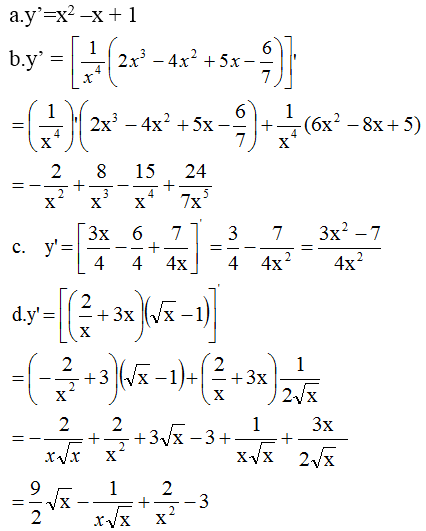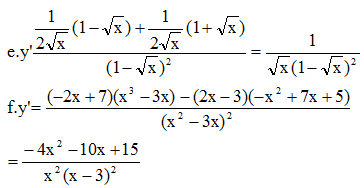Hãy nhập câu hỏi của bạn vào đây, nếu là tài khoản VIP, bạn sẽ được ưu tiên trả lời.

a) ĐK: \(\cos x\ne0\)( vì tan x = sinx/cosx nên cos x khác 0)
<=> \(x\ne\frac{\pi}{2}+k\pi\); k thuộc Z
TXĐ: \(ℝ\backslash\left\{\frac{\pi}{2}+k\pi\right\}\); k thuộc Z
b) ĐK: \(1+\cos2x\ne0\Leftrightarrow\cos2x\ne-1\Leftrightarrow2x\ne\pi+k2\pi\Leftrightarrow x\ne\frac{\pi}{2}+k\pi\); k thuộc Z
=> TXĐ: \(ℝ\backslash\left\{\frac{\pi}{2}+k\pi\right\}\); k thuộc Z
c) ĐK: \(\hept{\begin{cases}\cot x-\sqrt{3}\ne0\\\sin x\ne0\end{cases}}\Leftrightarrow\hept{\begin{cases}x\ne\frac{\pi}{6}+k\pi\text{}\text{}\\x\ne l\pi\end{cases}}\); k,l thuộc Z
=>TXĐ: ....
d) ĐK: \(1-2\sin^2x\ne0\Leftrightarrow\cos2x\ne0\Leftrightarrow2x\ne\frac{\pi}{2}+k\pi\Leftrightarrow x\ne\frac{\pi}{4}+\frac{k\pi}{2}\)
=> TXĐ:...

\(1.\hept{\begin{cases}2-2\cos x\ge0\\\sqrt{2-2\cos x}-2\ne0\end{cases}}\Leftrightarrow\hept{\begin{cases}\cos x\le1\left(đ\right)\\\cos x\ne-1\end{cases}}\Leftrightarrow x\ne\pi+k2\pi\left(k\in Z\right)\)
\(2.\hept{\begin{cases}\sin3x\ne0\\1+\sin3x\ge0\\1-\sqrt{1+\sin3x}\ne0\end{cases}}\Leftrightarrow\hept{\begin{cases}3x\ne k\pi\\\sin3x\ge-1\left(đ\right)\\\sin3x\ne0\end{cases}}\Leftrightarrow x\ne\frac{k\pi}{3}\left(k\in Z\right)\)
\(3.\hept{\begin{cases}\sin2x\ne0\\\sin x\ne0\end{cases}}\Leftrightarrow\hept{\begin{cases}2x\ne k\pi\\x\ne k\pi\end{cases}}\Leftrightarrow x\ne\frac{k\pi}{2}\left(k\in Z\right)\)

xét hàm số sau \(\frac{x+\sqrt{x^2+1}}{\sqrt{1+x^2-x}}+\frac{\sqrt{1+x^2-x}}{x+\sqrt{x^2+1}}\)
=\(\frac{\left(x+\sqrt{x^2+1}\right)\left(\sqrt{1+x^2}+x\right)}{\left(1+x^2\right)-x^2}+\frac{\left(\sqrt{1+x^2-x}\right)\left(\sqrt{x^2+1}-x\right)}{x^2+1-x^2}=\left(x+\sqrt{x^2+1}\right)^2+\left(\sqrt{x^2+1-x}\right)^2=4x^2+2\)

a) Cách 1: y' = (9 -2x)'(2x3- 9x2 +1) +(9 -2x)(2x3- 9x2 +1)' = -2(2x3- 9x2 +1) +(9 -2x)(6x2 -18x) = -16x3 +108x2 -162x -2.
Cách 2: y = -4x4 +36x3 -81x2 -2x +9, do đó
y' = -16x3 +108x2 -162x -2.
b) y' = .(7x -3) +
(7x -3)'=
(7x -3) +7
.
c) y' = (x -2)'√(x2 +1) + (x -2)(√x2 +1)' = √(x2 +1) + (x -2) = √(x2 +1) + (x -2)
= √(x2 +1) +
=
.
d) y' = 2tanx.(tanx)' - (x2)' =
.
e) y' = sin
=
sin
.


Lời giải:
Em không rõ ở phần tìm đạo hàm theo định nghĩa (lim) hay tìm đạo hàm dựa theo công thức
Thông thường lớp 11 thì thường áp dụng luôn công thức
Áp dụng công thức: \((u^{\alpha})'=\alpha.u'.u^{\alpha-1}\) thì:
\(y=(x+\sqrt{1+x^2})^{\frac{1}{2}}\)
\(\Rightarrow y'=\frac{1}{2}(x+\sqrt{x^2+1})'(x+\sqrt{x^2+1})^{\frac{1}{2}-1}\)
\(=\frac{(x+\sqrt{x^2+1})'}{2\sqrt{x+\sqrt{x^2+1}}}(*)\)
\((x+\sqrt{x^2+1})'=x'+(\sqrt{x^2+1})'=1+((x^2+1)^{\frac{1}{2}})'\)
\(=1+\frac{1}{2}(x^2+1)'(x^2+1)^{\frac{1}{2}-1}\)
\(=1+\frac{1}{2}.2x.\frac{1}{\sqrt{x^2+1}}=1+\frac{x}{\sqrt{x^2+1}}(**)\)
Từ \((*);(**)\Rightarrow y'=\frac{x+\sqrt{x^2+1}}{\sqrt{x^2+1}.2\sqrt{x+\sqrt{x^2+1}}}=\frac{1}{2}\sqrt{\frac{x+\sqrt{x^2+1}}{x^2+1}}\)
ta có : \(y'=\left(\sqrt{x+\sqrt{1+x^2}}\right)'=\dfrac{1}{2\sqrt{x+\sqrt{1+x^2}}}\left(x+\sqrt{1+x^2}\right)'\)
\(=\dfrac{1}{2\sqrt{x+\sqrt{1+x^2}}}\left(1+\dfrac{1}{2\sqrt{1+x^2}}\left(1+x^2\right)'\right)\) \(=\dfrac{1}{2\sqrt{x+\sqrt{1+x^2}}}\left(1+\dfrac{2x}{2\sqrt{1+x^2}}\right)\) \(=\dfrac{1}{2\sqrt{x+\sqrt{1+x^2}}}\left(\dfrac{x+\sqrt{1+x^2}}{\sqrt{1+x^2}}\right)=\dfrac{1}{2}\sqrt{\dfrac{x+\sqrt{1+x^2}}{1+x^2}}\)